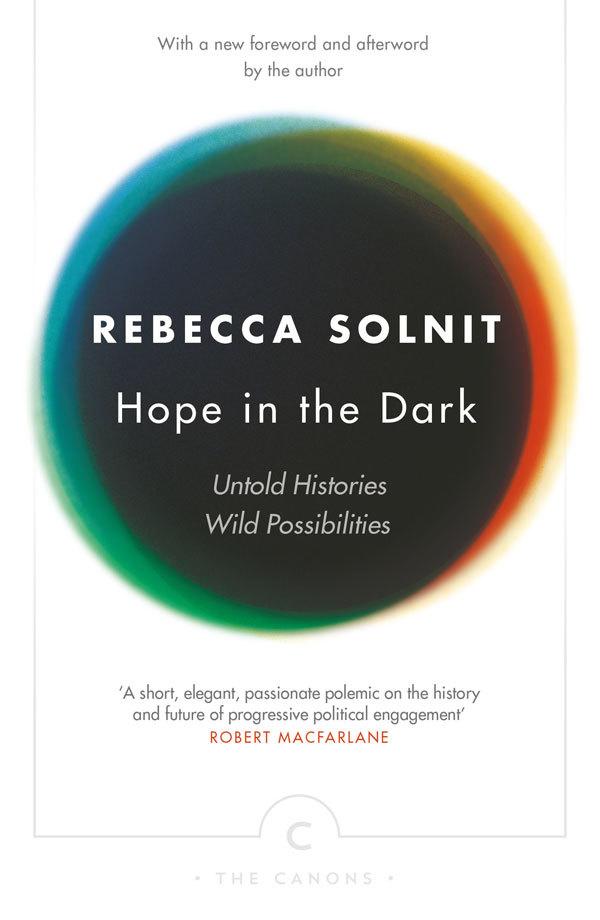Hope in the Dark, Untold Histories Wild Possibilities


Despair has become an all too familiar state. In the past decade, we have lived and continue to live through successive paradigmatic shifts. It often feels like we are caught in a seemingly never-ending chain of crises, social, political, cultural. Once you have experienced prolonged exposure to feelings of shock, anxiety and rage as the world shifts beneath your feet, hopelessness can easily become the base state.
At first, in the face of such change, it can seem baffling why more are not revolting in the streets. But revolts take energy, and there is only so much to give. Despair is what’s left when you accept that you cannot rail against every injustice. It’s a lonely, disconnected place that is hard to navigate out of alone. A little light, a little encouragement is needed to coax us back to feeling.
It’s been 16 years since Rebecca Solnit published Hope in the Dark, but it feels eerily relevant to today’s reader. Much has changed for the worse across the globe – growing populism and extremism, a resurgence of racism, misogyny and homophobia, increased police brutality, ethnic cleansing in Myanmar, to name but a fraction of the things to draw us into a state of despair and cynicism about our fellow humans. Arguably, it is because of these and other changes that this book has taken on a sense of urgency. One of her leaner volumes, it is a treatise arguing for hope in the face of the unrelentingly bleak. Written in Bush-era America, post-Iraq war, with all the attendant disillusionment progressives experienced, Solnit attempts to sketch an alternative legacy to draw strength from. In this book, she catalogues a series of victories as a tonic for those who feel like giving up the fight.
As a counterpoint to collective grief, she offers up a body of evidence testifying to the achievements that bloom from our struggles against injustice. Using the stories of grassroots action, uprisings and movements, she shows that times of the greatest uncertainty often bring out the best of humanity. Her examples of South American countries, where people United to overthrow military dictatorships with no guarantee of success is testament to how even the most seemingly small and insignificant of us can contribute to altering the course of history. It is a powerful example of the power of hope and persistence in spite of great uncertainty.
This is not a book that glosses over horrors, not is it a collection of carefully curated cheerful anecdotes – it is not a book that argues for naive blind faith that everything will be fine in the end. It makes peace with reality, and the messes we find ourselves in. Given the human tendency to focus on the negative, to forget our many successes, Solnit had striven to cache them in one place so that we can be reminded that everything is not always as hopeless as it feels. Through each story she cautions us that our own misery and malaise is often used as a tool of suppression, keeping us from fighting to change the status quo.
The book is a reminder that resistance movements don’t have to start from scratch – we have a legacy of rising up when beaten down. Today’s activists have been given a template by the movements of the past. Solnit shows us that we are not fumbling around without a clue how to respond – “the past is set in daylight, and it can become a torch we carry into the night that is the future”.
When we think of hope, there is a tendency to see it as passive, as a static feeling of optimism. Through each of these stories, we are presented with the argument that hope is an action word, a state that is replete with potential when we reach for it at our most downtrodden. As Solnit says:
“Hope is not a lottery ticket you can sit on the sofa and clutch, feeling lucky. It is an axe you break down doors with in an emergency. Hope should shove you out the door, because it will take everything you have to steer the future away from endless war, from the annihilation of the earth’s treasures and the grinding down of the poor and marginal”.
Cynicism will trap us. But hope is a catalyst for action. She argues that to hope is not just a radical stance in the face of so much anguish – but it is the very thing we need to inhabit the present as we work for something better.
Amen.

A useful article, thanks…but it set me on a course of reflecting about the definition of ‘hope’, how it actually shows itself in life. Are we saying that without hope, there would be no action? If that’s the case, then ‘hope’ is the same as ‘motivation’, isn’t it? When we lose motivation, then we become passive and that is what Solnit and the author of this piece, want not to occur.
My own attitude is to live without hope and just do what I can, without it. It seems to me as though hope is a fifth wheel, and sustaining it requires energy that could go elsewhere–into actions, for example. Again, this comes back to just what we mean by ‘hope’; it’s possible that without clarification, we are actually discussing a number of distinct human states, but under the rubric of a single word.